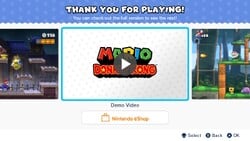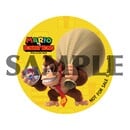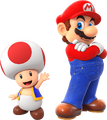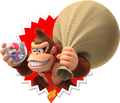Mario vs. Donkey Kong (Nintendo Switch): Difference between revisions
CyonOfGaia (talk | contribs) m (→Graphics: Reworded this better to avoid redundancy) |
CyonOfGaia (talk | contribs) (→Product info: Corrected the wrong boss link OOF, the GBA version crossed my mind for a second) Tag: Mobile edit |
||
| (34 intermediate revisions by 8 users not shown) | |||
| Line 5: | Line 5: | ||
|developer=[[Nintendo Software Technology Corporation]]<ref>[https://famiboards.com/threads/nintendo-first-party-software-development-st-nintendo-party-superstars.114/post-824453 Initial post about the Instagram story from an NST contractor] [https://famiboards.com/threads/nintendo-first-party-software-development-st-nintendo-party-superstars.114/post-824581 Instagram story itself]</ref> | |developer=[[Nintendo Software Technology Corporation]]<ref>[https://famiboards.com/threads/nintendo-first-party-software-development-st-nintendo-party-superstars.114/post-824453 Initial post about the Instagram story from an NST contractor] [https://famiboards.com/threads/nintendo-first-party-software-development-st-nintendo-party-superstars.114/post-824581 Instagram story itself]</ref> | ||
|publisher=[[Nintendo]] | |publisher=[[Nintendo]] | ||
|release={{ | |release={{flag list|Japan|February 16, 2024<ref name=JP>Nintendo (January 12, 2024). [https://www.nintendo.com/jp/switch/a97pa/index.html Mario vs. Donkey Kong | Nintendo Switch | Nintendo].</ref>|USA|February 16, 2024<ref name=Direct/>|Mexico|February 16, 2024<ref>[https://www.nintendo.com/es-mx/store/products/mario-vs-donkey-kong-switch/ Latin American website]. ''Nintendo.com (in Spanish)''.</ref>|Brazil|February 16, 2024<ref>[https://www.nintendo.com/pt-br/store/products/mario-vs-donkey-kong-switch/ Brazilian website]. ''Nintendo.com (in Portuguese)''.</ref>|Europe|February 16, 2024<ref>@NintendoEurope (September 14, 2023). [https://twitter.com/NintendoEurope/status/1702322976715411458 "''The toys are back in town! Recover the stolen Mini-Marios in this Game Boy Advance classic updated for #NintendoSwitch. Mario vs. Donkey Kong launches 16/02/2024! #NintendoDirect''"]. ''Twitter''. Retrieved September 14, 2023.</ref>|Australia|February 16, 2024<ref>NintendoAU (September 14, 2023). [https://youtu.be/4a0YZ-TFEqo Mario vs. Donkey Kong marches onto Nintendo Switch February 16th, 2024]. ''YouTube''. Retrieved September 14, 2023.</ref>|South Korea|February 16, 2024<ref>(September 14, 2023). [https://www.nintendo.co.kr/news/article/6WlUtB4pXCJW48l6XMSte3 『프린세스 피치 Showtime!』, 『페이퍼 마리오 1000년의 문』, 『루이지 맨션 2 HD』, 『마리오 vs. 동키콩』 등, Nintendo Switch로 발매되는 타이틀의 최신 정보를 전달!] ''Nintendo Korea''. Retrieved September 14, 2023.</ref>|HK|February 16, 2024<ref>(September 14, 2023). [https://www.nintendo.com.hk/topics/article/1qmXxqSB4YwuXsXqTYW2n9 《瑪利歐vs.咚奇剛》的最新資訊公開!本作預定於2024年2月16日(五)發售。] ''Nintendo HK''. Retrieved September 14, 2023.</ref>|ROC|February 16, 2024<ref>(February 16, 2024). [https://www.nintendo.tw/topics/article/1i1ljlGmoPWsxrrIC6 Nintendo Switch《瑪利歐vs.咚奇剛》本日發售。現正公開迷你瑪利歐的定格影片。] ''Nintendo TW''. Retrieved February 21, 2024.</ref>}} | ||
|languages={{languages|en_us=y|en_gb=y|fr_fr=y|fr_ca=y|es_es=y|es_latam=y|de=y|it=y|nl=y|jp=y|zh_simp=y|zh_trad=y|kr=y}} | |languages={{languages|en_us=y|en_gb=y|fr_fr=y|fr_ca=y|es_es=y|es_latam=y|de=y|it=y|nl=y|jp=y|zh_simp=y|zh_trad=y|kr=y}} | ||
|genre=[[Genre#Puzzle|Puzzle]]/Action | |genre=[[Genre#Puzzle|Puzzle]]/Action | ||
|modes=Single-player, local multiplayer | |modes=Single-player, local multiplayer | ||
|ratings={{ratings|esrb=E|cero=A|pegi=3|acb=G|grac=All|usk=0|classind=L|smeccv=A|gsrr=P|rars= |fpb=13|gcam=3|mro=3}} | |ratings={{ratings|esrb=E|cero=A|pegi=3|acb=G|grac=All|usk=0|classind=L|smeccv=A|gsrr=P|rars=|fpb=13|gcam=3|mro=3}} | ||
|platforms=[[Nintendo Switch]] | |platforms=[[Nintendo Switch]] | ||
|format={{format|switch=1|switchdl=1}} | |format={{format|switch=1|switchdl=1}} | ||
|input={{input|joy-con=1|joy-con-horizontal=1|switchpro=1}} | |input={{input|joy-con=1|joy-con-horizontal=1|switchpro=1}} | ||
|serials={{ | |serials={{flag list|USA|HAC-P-A97PA}} | ||
}} | }} | ||
{{quote|The rivalry reignites.|Advertisement tagline for ''Mario vs. Donkey Kong''}} | {{quote|The rivalry reignites.|Advertisement tagline for ''Mario vs. Donkey Kong''}} | ||
| Line 19: | Line 19: | ||
A free demo of the game was released on the [[Nintendo eShop]] on January 31, 2024.<ref>https://twitter.com/NintendoAmerica/status/1752859619943194810</ref> This is the first ''Super Mario'' title to omit the ESRB rating on the box art version officially distributed in the Southeast Asian markets<!-- The Middle East does not count as Saudi Arabia has had a native age rating system since 2016, and the U.A.E. has had one since 2018. Oman does not have one, but it shares its gaming market with the U.A.E. in general. -->, although the first Nintendo-published title overall to omit the rating in those markets is ''[[nwiki:Another Code: Recollection|Another Code: Recollection]]''.<ref>https://nintendosoup.com/all-first-party-nintendo-physical-games-in-southeast-asia-will-not-have-a-rating-on-the-cover-starting-from-another-code/</ref> | A free demo of the game was released on the [[Nintendo eShop]] on January 31, 2024.<ref>https://twitter.com/NintendoAmerica/status/1752859619943194810</ref> This is the first ''Super Mario'' title to omit the ESRB rating on the box art version officially distributed in the Southeast Asian markets<!-- The Middle East does not count as Saudi Arabia has had a native age rating system since 2016, and the U.A.E. has had one since 2018. Oman does not have one, but it shares its gaming market with the U.A.E. in general. -->, although the first Nintendo-published title overall to omit the rating in those markets is ''[[nwiki:Another Code: Recollection|Another Code: Recollection]]''.<ref>https://nintendosoup.com/all-first-party-nintendo-physical-games-in-southeast-asia-will-not-have-a-rating-on-the-cover-starting-from-another-code/</ref> | ||
==Changes from the original game== | ==Changes from the original game== | ||
===New content=== | ===New content=== | ||
=====Game modes===== | =====Game modes===== | ||
*[[Easy Mode | *An [[Easy Mode]] known as '''Casual Style'''<ref>"'''Casual Style:''' For a more relaxed experience, this style of play removes the timer, adds checkpoints, and boosts the number of times Mario can get hit." -''Mario vs. Donkey Kong™ for Nintendo Switch - Nintendo Official Site. (n.d.). Retrieved June 24, 2024, from https://www.nintendo.com/us/store/products/mario-vs-donkey-kong-switch/''</ref> has been added, with the following changes from Classic: | ||
** | **There is no time limit, which also causes the timer to display with an infinity sign. | ||
**The player starts with five bubbles per level. If the player has any bubbles left, the character will return to the last active [[Checkpoint Flag]] in a [[bubble]] in situations that would cause them to lose a life. | **The player starts with five bubbles per level. If the player has any bubbles left, the character will return to the last active [[Checkpoint Flag]] in a [[bubble]] in situations that would cause them to lose a life. | ||
**Multiple Checkpoint Flags are scattered across several levels. Each of these flags can be tagged to unfurl them and make them usable as a checkpoint, however only one can be active at a time. | **Multiple Checkpoint Flags are scattered across several levels. Each of these flags can be tagged to unfurl them and make them usable as a checkpoint, however only one can be active at a time. | ||
| Line 36: | Line 37: | ||
**Multiplayer is not available during Time Attack mode. | **Multiplayer is not available during Time Attack mode. | ||
*In addition to regular keys that appear in the main levels, a silver [[flying key]] must also be caught during Multiplayer sessions to use on locked doors and [[Toy box (object)|toy box]]es. | *In addition to regular keys that appear in the main levels, a silver [[flying key]] must also be caught during Multiplayer sessions to use on locked doors and [[Toy box (object)|toy box]]es. | ||
*If a player is defeated in Multiplayer while another is still alive, they will float back to the player in a [[bubble]]. The player can repeatedly press {{button|switch|A}} or {{button|switch|B}} to float back faster. | *If a player is defeated in Multiplayer while another is still alive, they will float back to the remaining player in a [[bubble]]. The player can repeatedly press {{button|switch|A}} or {{button|switch|B}} to float back faster. | ||
**Players who get defeated will still lose a life in that way, with similar mechanics to ''[[Super Mario 3D World]]''. | **Players who get defeated will still lose a life in that way, with similar mechanics to ''[[Super Mario 3D World]]''. | ||
*In some cases, the camera will also zoom out to accommodate for showing two players on the same screen, eventually to the point that there will be blurred borders present on-screen (which is a visual representation of the level boundaries). | |||
=====Levels===== | =====Levels===== | ||
*Two new worlds, [[Merry Mini-Land]] and [[Slippery Summit]], have been introduced as this version of the game's fourth and sixth worlds respectively, with each incorporating new obstacles like [[Flower Fan]]s, carryable [[Spring]]s, [[Warp Box]]es and icy terrain. | *Two new worlds, [[Merry Mini-Land]] and [[Slippery Summit]], have been introduced as this version of the game's fourth and sixth worlds respectively, with each incorporating new obstacles like [[Flower Fan]]s, carryable [[Spring]]s, [[Warp Box]]es and [[Ice Block|icy terrain]]. | ||
**As such, the order of worlds has been rearranged slightly to accommodate the new worlds, bringing the total number of worlds to eight instead of six: | **As such, the order of worlds has been rearranged slightly to accommodate the new worlds, bringing the total number of worlds to eight instead of six: | ||
***[[Mario Toy Company]] | ***[[Mario Toy Company]] | ||
| Line 54: | Line 56: | ||
**Expert levels are now split into two world sets containing eight levels each, coded EX1 and EX2 respectively. They are also now unlocked after [[vs. Donkey Kong]] is beaten, instead of after [[vs. Donkey Kong Plus]]. | **Expert levels are now split into two world sets containing eight levels each, coded EX1 and EX2 respectively. They are also now unlocked after [[vs. Donkey Kong]] is beaten, instead of after [[vs. Donkey Kong Plus]]. | ||
**The gold star requirements have slightly changed for the Expert levels, with them now having values in multiples of eight ([[Level EX-1]] requires 8 stars, and [[Level EX-16]] requires 128 stars, for example) | **The gold star requirements have slightly changed for the Expert levels, with them now having values in multiples of eight ([[Level EX-1]] requires 8 stars, and [[Level EX-16]] requires 128 stars, for example) | ||
*The bonus present minigames have been replaced with various new bonus levels | *The bonus present minigames have been replaced with various new bonus levels. In these levels, the player must catch a [[flying key]] that opens a chest before the time runs out, earning five [[Extra life|1-Ups]] in the process. | ||
**There are sixteen new bonus levels that correspond to each world (excluding Expert sets EX1 and EX2), with some level layouts derived from existing levels (both old and new). | **There are sixteen new bonus levels that correspond to each world (excluding Expert sets EX1 and EX2), with some level layouts derived from existing levels (both old and new). | ||
**Bonus levels can appear after approximately every eighth regular level beaten, with the bonus level corresponding to the last world said level was beaten on. On newly unlocked worlds, it is designed in such a way that up to 4-6 regular levels in the same world must be beaten to open the bonus level for that respective world. | **Bonus levels can appear after approximately every eighth regular level beaten, with the bonus level corresponding to the last world said level was beaten on. On newly unlocked worlds, it is designed in such a way that up to 4-6 regular levels in the same world must be beaten to open the bonus level for that respective world. | ||
| Line 61: | Line 63: | ||
=====Gameplay===== | =====Gameplay===== | ||
*The scoring system has been removed. As such, the requirements for collecting gold stars has been changed to be performance based. | *The scoring system has been removed. As such, the requirements for collecting gold stars has been changed to be performance based. | ||
**A "Perfect!" rating (still represented by a gold star) can be obtained in all levels, excluding [[vs. Donkey Kong]] and its [[Donkey Kong Plus|Plus variant]]. It is obtained by clearing a level with all [[Present (Mario vs. Donkey Kong)|presents]], getting all six [[Mini-Mario]]s in the [[Toy box (object)|toy box]] in the Mini-Mario (mm) levels, and | **A "Perfect!" rating (still represented by a gold star) can be obtained in all levels, excluding [[vs. Donkey Kong]] and its [[Donkey Kong Plus|Plus variant]]. It is obtained by clearing a level with all [[Present (Mario vs. Donkey Kong)|presents]], getting all six [[Mini-Mario]]s in the [[Toy box (object)|toy box]] in the Mini-Mario (mm) levels, and completing a boss battle without taking damage. | ||
*Falls are no longer lethal, and only formerly lethal falls now stun the player. Additionally, falls that would non-lethally stun the player in the original no longer do so. | *Falls are no longer lethal, and only formerly lethal falls now stun the player. Additionally, falls that would non-lethally stun the player in the original no longer do so. | ||
*Retrying or exiting a level that has not been cleared yet no longer costs the player a life. | *Retrying or exiting a level that has not been cleared yet no longer costs the player a life. | ||
| Line 93: | Line 95: | ||
*The title screen now has Mario and Donkey Kong with more movements than just their eyes blinking like in the original. | *The title screen now has Mario and Donkey Kong with more movements than just their eyes blinking like in the original. | ||
*Various backgrounds and terrain in all levels have been overhauled, with the terrain being changed from simple blocky tiles to various ground types that match the theming of the current level. | *Various backgrounds and terrain in all levels have been overhauled, with the terrain being changed from simple blocky tiles to various ground types that match the theming of the current level. | ||
**As a consequence, [[Color Block]]s do not share the same appearance with the level's current tileset unlike in the GBA version, as they use their [[Mario Toy Company]] design regardless of the current world. | |||
*In some worlds that take place at night-time (including [[Twilight City]] and [[Merry Mini-Land Plus]]), blue Color Blocks, ladders, and other related objects are depicted with brighter colors, making them easier to discern. | |||
*Various items and objects are updated to newer designs: | *Various items and objects are updated to newer designs: | ||
**[[Present (Mario vs. Donkey Kong)|Present]]s are now completely colored instead of white with a colored ribbon. | **[[Present (Mario vs. Donkey Kong)|Present]]s are now completely colored instead of white with a colored ribbon. | ||
| Line 113: | Line 117: | ||
**[[Bob-omb]]s are redesigned to be slightly more mechanical and toylike. They are also no longer pink when thrown by Donkey Kong in some of his boss battles. | **[[Bob-omb]]s are redesigned to be slightly more mechanical and toylike. They are also no longer pink when thrown by Donkey Kong in some of his boss battles. | ||
**[[Sir Shovalot]]s are further redesigned, with a silver-colored traditional knight's shield instead of a yellow round one, a slightly larger body, and black wheels instead of blue ones. | **[[Sir Shovalot]]s are further redesigned, with a silver-colored traditional knight's shield instead of a yellow round one, a slightly larger body, and black wheels instead of blue ones. | ||
**There is a blue, ice-like variant of [[Fireball (Donkey Kong)|Fireball]] that appears in Slippery Summit, which behaves no differently from a standard Fireball. | **There is a blue, ice-like variant of [[Fireball (Donkey Kong)|Fireball]] that appears in Slippery Summit, which behaves no differently from a standard Fireball. Touching it will cause Mario to play his fire death animation, but with icy effects and sounds instead of smoke. | ||
*Mario's normal and fire death animations now resemble the ones commonly used in modern mainline ''Super Mario'' games, rather than showing him recoil and collapse on the floor, and he is no longer charred when he dies from touching fire. | *Mario's normal and fire death animations now resemble the ones commonly used in modern mainline ''Super Mario'' games, rather than showing him recoil and collapse on the floor, and he is no longer charred when he dies from touching fire. | ||
*Donkey Kong has an angrier expression when he has one hit point left in his boss battles. | *Donkey Kong has an angrier expression when he has one hit point left in his boss battles. | ||
*The Game Over screen has been slightly altered: | *The Game Over screen has been slightly altered: | ||
| Line 129: | Line 132: | ||
*The Toads no longer make Donkey Kong fall off the building by stepping on his hand, and both them and Mario look in concern when he falls. | *The Toads no longer make Donkey Kong fall off the building by stepping on his hand, and both them and Mario look in concern when he falls. | ||
*Instead of sobbing, Donkey Kong is shown sulking after his defeat in the final cutscene, and Mario does not scold him before giving him the Mini-Mario. However, he does sob after being defeated in-game. | *Instead of sobbing, Donkey Kong is shown sulking after his defeat in the final cutscene, and Mario does not scold him before giving him the Mini-Mario. However, he does sob after being defeated in-game. | ||
** Fireworks also appear at the end of the cutscene after Mario gives | ** Fireworks also appear at the end of the cutscene after Mario gives Donkey Kong a Mini-Mario toy. | ||
=====Audio===== | =====Audio===== | ||
*The music has been rearranged like other [[reissue|remake]]s. | *The music has been rearranged like other [[reissue|remake]]s. | ||
**Some songs feature extended melodies not heard in their original counterparts, which is notable in songs like the third [[Spooky House]] theme. | **Some songs feature extended melodies not heard in their original counterparts, which is notable in songs like the third [[Spooky House]] theme. | ||
**The bonus minigame music, while also rearranged, has been relegated to the new bonus levels instead. | |||
*Several songs in the soundtrack have been completely replaced by new tracks: | *Several songs in the soundtrack have been completely replaced by new tracks: | ||
**[[Fire Mountain (world)|Fire Mountain]]'s music now features a more mysterious and adventure-like feel as opposed to a more upbeat percussion and melodies. | **[[Fire Mountain (world)|Fire Mountain]]'s music now features a more mysterious and adventure-like feel as opposed to a more upbeat percussion and melodies. | ||
| Line 149: | Line 153: | ||
*Some voice cues no longer occur in some cutscenes and gameplay, with the most notable ones being: | *Some voice cues no longer occur in some cutscenes and gameplay, with the most notable ones being: | ||
**Mario saying the title of the game on the title screen. | **Mario saying the title of the game on the title screen. | ||
**Mario saying, "Way to go!" when a boss level has been completed. | **Mario saying, "Way to go!", "Good job!", and "All you, it's all you, baby!" when a boss level has been completed. | ||
**Mario, the Mini-Marios, and the Toads laughing at Donkey Kong before the first final boss battle and [[Donkey Kong Plus]]. | **Mario, the Mini-Marios, and the Toads laughing at Donkey Kong before the first final boss battle and [[Donkey Kong Plus]]. | ||
**Mario asking, "Hey, Donkey Kong! Are you okay?" in the cutscene before the "Plus" levels. | **Mario asking, "Hey, Donkey Kong! Are you okay?" in the cutscene before the "Plus" levels. | ||
| Line 197: | Line 201: | ||
|Items that can be grabbed by Mario and used to defeat enemies. | |Items that can be grabbed by Mario and used to defeat enemies. | ||
|- | |- | ||
|align=center|[[File: | |align=center|[[File:MarioVsDKSwitch Key.png|70px]]<br>[[Key]] | ||
|Keys are found in the first half of every regular level of the game. They must be taken to locked doors in order to open the second half. | |Keys are found in the first half of every regular level of the game. They must be taken to locked doors in order to open the second half. | ||
|- | |- | ||
|align=center|[[File: | |align=center|[[File:MarioVsDKSwitch_LetterBlockT.png|40px]][[File:MarioVsDKSwitch_LetterBlockO.png|40px]][[File:MarioVsDKSwitch_LetterBlockY.png|40px]]<br>[[Letter Block]]s | ||
|Letters that spell out the word "TOY" appearing exclusively in Mini-Mario levels that must be collected to complete the level. They can only be collected by the Mini-Marios. | |Letters that spell out the word "TOY" appearing exclusively in Mini-Mario levels that must be collected to complete the level. They can only be collected by the Mini-Marios. | ||
|- | |- | ||
| Line 238: | Line 242: | ||
|Snifit-like Shy Guys that attack the player(s) with fire from their mask. | |Snifit-like Shy Guys that attack the player(s) with fire from their mask. | ||
|- | |- | ||
|align=center|[[File:MvsDK Switch Fireball.png| | |align=center|[[File:MvsDK Switch Fireball.png|62px]][[File:BlueFireballMvsDKSwitch.png|50px]]<br>[[Fireball (Donkey Kong)|Fireball]]s | ||
|Enemies that move from side to side on a platform. Upon contact, | |Enemies that move from side to side on a platform. Upon contact, orange ones burn the player and blue ones freeze. | ||
|- | |- | ||
|align=center|[[File:LavaBubbleMVDK.png|90px]]<br>[[Lava Bubble]]s | |align=center|[[File:LavaBubbleMVDK.png|90px]]<br>[[Lava Bubble]]s | ||
|Enemies that are found jumping repeatedly out of [[lava]], and burn the player(s) upon touching them. | |Enemies that are found jumping repeatedly out of [[lava]], and burn the player(s) upon touching them. | ||
|- | |- | ||
|align=center|[[File: | |align=center|[[File:MvDK NS Monchee.png|90px]]<br>[[Monchee]]s | ||
|Mechanical monkeys with long tails that hang below the platforms they are on. Mario can hang from their tails without getting harmed. However, he still loses an extra life if he touches a Monchee's body. | |Mechanical monkeys with long tails that hang below the platforms they are on. Mario can hang from their tails without getting harmed. However, he still loses an extra life if he touches a Monchee's body. | ||
|- | |- | ||
| Line 250: | Line 254: | ||
|Mechanical enemies wearing black ninja outfits with two red buttons. They jump repeatedly in place, and can be used as platforms to traverse spikes. | |Mechanical enemies wearing black ninja outfits with two red buttons. They jump repeatedly in place, and can be used as platforms to traverse spikes. | ||
|- | |- | ||
|align=center|[[File: | |align=center|[[File:MarioVsDKSwitch PolterguyRed.png|60px]][[File:MarioVsDKSwitch PolterguyYellow.png|60px]][[File:MarioVsDKSwitch PolterguyBlue.png|60px]]<br>[[File:MarioVsDKSwitch PolterguyRedBlock.png|60px]][[File:MarioVsDKSwitch PolterguyYellowBlock.png|60px]][[File:MarioVsDKSwitch PolterguyBlueBlock.png|60px]]<br>[[Polterguy]]s | ||
|Wind-up Shy Guy ghost enemies that transform into blocks when the player(s) press a Color Switch. | |Wind-up Shy Guy ghost enemies that transform into blocks when the player(s) press a Color Switch. | ||
|- | |- | ||
|align=center|[[File: | |align=center|[[File:MarioVsDKSwitch_RamRam.png|90px]]<br>[[RamRam]]s | ||
|Purple rhinoceroses resembling [[Rambi]], an animal friend from ''[[Donkey Kong Country]]''. They attack by charging at and ramming the player(s). RamRams can be picked up and thrown on to [[Spike Trap|spike]]s, allowing them to be used as platforms. | |Purple rhinoceroses resembling [[Rambi]], an animal friend from ''[[Donkey Kong Country]]''. They attack by charging at and ramming the player(s). RamRams can be picked up and thrown on to [[Spike Trap|spike]]s, allowing them to be used as platforms. | ||
|- | |- | ||
| Line 268: | Line 272: | ||
|Crocodile-like enemies that climb [[rope]]s. They can only be defeated by falling fruit. | |Crocodile-like enemies that climb [[rope]]s. They can only be defeated by falling fruit. | ||
|- | |- | ||
|align=center|[[File: | |align=center|[[File:MarioVsDKSwitch_SpearGuyAsleep.png|90px]]<br>[[Spear Guy]]s | ||
|Enemies that are first found sleeping. Once Mario gets near them, they wake up and start running after him. They go back to sleep if they touch a platform's edge. | |Enemies that are first found sleeping. Once Mario gets near them, they wake up and start running after him. They go back to sleep if they touch a platform's edge. | ||
|- | |- | ||
| Line 280: | Line 284: | ||
|Enemies that fall down when the player(s) approach them. Touching one causes an extra life to be lost. | |Enemies that fall down when the player(s) approach them. Touching one causes an extra life to be lost. | ||
|- | |- | ||
|align=center|[[File: | |align=center|[[File:MarioVsDKSwitch WrenchShyGuy.png|90px]]<br>[[Wrench Shy Guy]]s | ||
|Black Shy Guys that throw spanners | |Black Shy Guys that throw spanners which fly in a straight line towards the player. | ||
|} | |} | ||
| Line 293: | Line 297: | ||
|Objects that birds can spawn from. | |Objects that birds can spawn from. | ||
|- | |- | ||
|align=center|[[File: | |align=center|[[File:MarioVsDKSwitchCandle.png|90px]]<br>[[Candle]] | ||
|Obstacles that moves up and down and burn the player(s) on contact. They can be defeated with a [[Hammer]]. | |Obstacles that moves up and down and burn the player(s) on contact. They can be defeated with a [[Hammer]]. | ||
|- | |- | ||
|align=center|[[File: | |align=center|[[File:MarioVsDKSwitch Cannon.png|90px]]<br>[[Cannon]] | ||
|Obstacles that tilt up and down, firing cannonballs. | |Obstacles that tilt up and down, firing cannonballs. | ||
|- | |- | ||
|align=center|[[File: | |align=center|[[File:MarioVsDKSwitch Cannonball.png|90px]]<br>[[Cannonball]] | ||
|Obstacles that are fired from cannons. | |Obstacles that are fired from cannons. | ||
|- | |- | ||
|align=center|[[File: | |align=center|[[File:MarioVsDKSwitch FallingSpike.png|90px]]<br>[[Falling spike]] | ||
|Spikes that fall from ceilings as Mario gets near them. Falling spikes that get stuck on the ground act as temporary platforms for the player. | |Spikes that fall from ceilings as Mario gets near them. Falling spikes that get stuck on the ground act as temporary platforms for the player. | ||
|- | |- | ||
|align=center|[[File:FlowerFanRedOff.png|50px]][[File: | |align=center|[[File:FlowerFanRedOff.png|50px]][[File:MarioVsDKSwitch YellowFlowerFanOff.png|50px]][[File:MarioVsDKSwitch BlueFlowerFanOff.png|50px]]<br>[[File:FlowerFanRedOn.png|50px]][[File:MarioVsDKSwitch YellowFlowerFanOn.png|50px]][[File:MarioVsDKSwitch BlueFlowerFanOn.png|50px]]<br>[[Flower Fan]] | ||
|Floating, fan-like flowers that produce a continuous gust, which can carry Mario and various objects in one direction. Flower Fans of a specific color are activated simultaneously by pressing a corresponding Color Switch. | |Floating, fan-like flowers that produce a continuous gust, which can carry Mario and various objects in one direction. Flower Fans of a specific color are activated simultaneously by pressing a corresponding Color Switch. | ||
|- | |- | ||
|align=center|[[File: | |align=center|[[File:MarioVsDKSwitch Icicle.png|90px]]<br>[[Icicle]] | ||
|Icy stalactites that function identically to falling spikes. | |Icy stalactites that function identically to falling spikes. | ||
|- | |- | ||
| Line 314: | Line 318: | ||
|Spouts of lava that rise and cause [[Lift]]s to float on top of them, allowing the player(s) to reach higher ground. | |Spouts of lava that rise and cause [[Lift]]s to float on top of them, allowing the player(s) to reach higher ground. | ||
|- | |- | ||
|align=center|[[File: | |align=center|[[File:MarioVsDKSwitch_Oil.png|90px]]<br>[[Oil]] | ||
|Obstacles that move up and down and burn the player(s) on contact. They can be defeated with a Hammer. | |Obstacles that move up and down and burn the player(s) on contact. They can be defeated with a Hammer. | ||
|- | |- | ||
| Line 337: | Line 341: | ||
!width=88%|Description | !width=88%|Description | ||
|- | |- | ||
|align=center|[[File: | |align=center|[[File:MarioVsDKSwitch BobombBlock.png|80px]]<br>[[Bob-omb Block]] | ||
|Blocks that can only be destroyed by [[Bob-omb]]s. | |Blocks that can only be destroyed by [[Bob-omb]]s. | ||
|- | |||
|align=center|[[File:MarioVsDKSwitch ColorBlockRed.png|48px]][[File:MarioVsDKSwitch ColorBlockYellow.png|48px]][[File:MarioVsDKSwitch ColorBlockBlue.png|48px]]<br>[[File:DottedLineBlockRedMVDK.png|49px]][[File:DottedLineBlockYellowMVDK.png|50px]][[File:DottedLineBlockBlueMVDK.png|50px]]<br>[[Color Block]] | |||
|Blocks that become solid once a [[Color Switch]] of the same color is activated by the player(s), however any blocks that are of the inactive color will become inactive and intangible. | |||
|- | |- | ||
|align=center|[[File:MvsDK NS Donut Block.png|80px]]<br>[[Donut Block]] | |align=center|[[File:MvsDK NS Donut Block.png|80px]]<br>[[Donut Block]] | ||
|Orange blocks that fall if the player stands on them for too long. | |Orange blocks that fall if the player stands on them for too long. | ||
|- | |- | ||
|align=center|[[File:HelpBlockMVDK.png|80px]]<br>[[Message Block|Help Block]] | |align=center|[[File:HelpBlockMVDK.png|80px]]<br>[[Message Block|Help Block]] | ||
| Line 365: | Line 369: | ||
!width=88%|Description | !width=88%|Description | ||
|- | |- | ||
|align=center|[[File: | |align=center|[[File:MarioVsDKSwitch Lift.png|100px]]<br>[[Lift]] | ||
|Platforms that are found traveling along tracks, or being lifted by [[Lava Geyser]]s. | |Platforms that are found traveling along tracks, or being lifted by [[Lava Geyser]]s. | ||
|- | |- | ||
|align=center|[[File: | |align=center|[[File:MarioVsDKSwitch Semisolid.png|120px]][[File:MarioVsDKSwitch SemisolidRed.png|120px]][[File:MarioVsDKSwitch SemisolidYellow.png|120px]][[File:MarioVsDKSwitch SemisolidBlue.png|120px]]<br>[[Semisolid Platform]] | ||
|Platforms of varying styles that have solid surfaces, but can be jumped through from below. | |Platforms of varying styles that have solid surfaces, but can be jumped through from below. | ||
|} | |} | ||
| Line 378: | Line 382: | ||
!width=88%|Description | !width=88%|Description | ||
|- | |- | ||
|align=center|[[File: | |align=center|[[File:MarioVsDKSwitch Barrel.png|79px]]<br>[[Barrel]] | ||
|Can be carried and thrown by the player(s). They can be used to defeat certain enemies, or as auxiliary platforms to reach other platforms or to pass wide gaps with [[Spike Trap|spike]]s. | |Can be carried and thrown by the player(s). They can be used to defeat certain enemies, or as auxiliary platforms to reach other platforms or to pass wide gaps with [[Spike Trap|spike]]s. | ||
|- | |- | ||
|align=center|[[File: | |align=center|[[File:MarioVsDKSwitch CheckpointFlagActive.png|70px]][[File:MarioVsDKSwitch CheckpointFlagInactive.png|59px]]<br>[[Checkpoint Flag]] | ||
|A flag with Mario's insignia on it that acts as a checkpoint for players in the [[Easy Mode|Casual Style]]. Inactive Checkpoint Flags can be unfurled by coming into contact with one, which will become a new checkpoint that the player will return to upon getting bubbled. | |A flag with Mario's insignia on it that acts as a checkpoint for players in the [[Easy Mode|Casual Style]]. Inactive Checkpoint Flags can be unfurled by coming into contact with one, which will become a new checkpoint that the player will return to upon getting bubbled. | ||
|- | |- | ||
|align=center|[[File:MvDK NS Switch.png|60px]][[File: | |align=center|[[File:MvDK NS Switch.png|60px]][[File:MarioVsDKSwitch_ColorSwitchYellow.png|63px]][[File:MarioVsDKSwitch_ColorSwitchBlue.png|58px]]<br>[[Color Switch]] | ||
|Switches that are found in three versions: red, yellow, and blue. As the main effect, the switch that is active makes platforms, blocks, and ladders of the same color available to use. | |Switches that are found in three versions: red, yellow, and blue. As the main effect, the switch that is active makes platforms, blocks, and ladders of the same color available to use. | ||
|- | |- | ||
| Line 393: | Line 397: | ||
|Can be carried and thrown by the player(s). They can be used to defeat certain enemies, or as auxiliary platforms to reach other platforms or to pass wide gaps with [[Spike Trap|spike]]s. | |Can be carried and thrown by the player(s). They can be used to defeat certain enemies, or as auxiliary platforms to reach other platforms or to pass wide gaps with [[Spike Trap|spike]]s. | ||
|- | |- | ||
|align=center|[[File: | |align=center|[[File:MarioVsDKSwitch Ladder.png|50px]][[File:MarioVsDKSwitch LadderRed.png|40px]][[File:MarioVsDKSwitch LadderYellow.png|50px]][[File:MarioVsDKSwitch LadderBlue.png|50px]]<br>[[Ladder]] | ||
|Climbable objects of various lengths and visual styles. Some can be | |Climbable objects of various lengths and visual styles. Some can be toggled by Color Switches, with inactive ones appearing as dotted-lines and cannot be climbed. | ||
|- | |- | ||
|align=center|[[File:RopeMVDK.png|40px | |align=center|[[File:RopeMVDK.png|40px]]<br>[[Rope]] | ||
|Climbable objects that hang from trees or metal rings. [[Snapjaw]]s can be found moving along some vertical ropes | |Climbable objects that hang from trees or metal rings. The player can climb on them in a similar fashion to the vines from ''[[Donkey Kong Jr.]]''. [[Snapjaw]]s can be found moving along some vertical ropes. | ||
|- | |- | ||
|align=center|[[File:MvDK NS Spring.png|60px]]<br>[[Yellow Spring|Spring]] | |align=center|[[File:MvDK NS Spring.png|60px]]<br>[[Yellow Spring|Spring]] | ||
| Line 408: | Line 412: | ||
|Objects that constantly move platforms along a set path. | |Objects that constantly move platforms along a set path. | ||
|- | |- | ||
|align=center|[[File: | |align=center|[[File:MarioVsDKSwitch Trampoline.png|60px]]<br>[[Trampoline]] | ||
|Functions the same as springs but can also be picked up and thrown. | |Functions the same as springs but can also be picked up and thrown. | ||
|- | |||
|align=center|[[File:MarioVsDKSwitch_Wire.png|220px]][[File:MarioVsDKSwitch_WireRope.png|220px]]<br>[[Wire]] | |||
|Horizontal cables that the player can hang on to and move across. The player can also perform a [[Wire Spin]] on them to launch themselves to higher places. In worlds like [[Donkey Kong Jungle]], wires take the appearance of horizontal ropes. | |||
|} | |} | ||
==Demo== | |||
[[File:MarioVsDKSwitchDemoTitleScreen.jpg|250px|thumb|right|The title screen for the demo version]] | |||
A demo for the game was released on January 31, 2024 via the game's [[Nintendo eShop]] page, featuring a limited version of the game's first world, [[Mario Toy Company]]. The following differences are present in the demo version of the game: | |||
*The intro cutscene does not play upon first starting up the game, instead it immediately boots to the title screen. | |||
*The title screen features only two options: "Play Demo" and "Nintendo eShop". Selecting the latter option will allow the player to check out the game's relevant eShop page. As such, the file select menu and Gallery are absent, and accessing Guides and Controller options can only be done from the pause menu. | |||
*Multiplayer is still available, as with the option to choose between the [[Easy Mode|Casual]] or Classic play styles. | |||
*The only playable levels are [[Level 1-1 (Mario vs. Donkey Kong)|Level 1-1]], [[Level 1-3 (Mario vs. Donkey Kong)|Level 1-3]], [[Level 1-5 (Mario vs. Donkey Kong)|Level 1-5]], and [[Level 1-mm]]. The player can gain a total of four gold stars from them. | |||
**Additionally, the name of the world ("Mario Toy Company") is not displayed, instead showing the ''Mario vs. Donkey Kong'' logo. The world name can still be seen in the pause menu and in the level results screen. | |||
*Completion of Level 1-mm does not lead to [[Level 1-DK]], rather it leads to the demo video, which is a trailer that showcases various features and levels from the full version of the game. | |||
**The demo video is treated like a cutscene, which can also be skipped by holding {{button|switch|A}}. Once the video finishes playing, the player is asked if they want to check out the eShop page for the game. | |||
*A new menu appears after beating the game - the Product Info page, which can be viewed either by selecting No after watching the demo video for the first time, or by pressing {{button|switch|X}} while on the level select screen. (see below section for more details) | |||
*Some oddities are present in the demo: | |||
**An audiovisual bug is present in which Mario's burn animation is slightly incomplete - it lacks a burning sound and a smoke effect, while Mario's animations are still functional. This can be seen if Mario is defeated by touching [[Oil]]. | |||
**When viewing Mario's moves via the Guides menu (accessed via the pause screen), there are still references to moves related to climbing [[rope]]s - these only appear in [[Donkey Kong Jungle]] onward, which cannot be played in the demo. | |||
<gallery> | |||
MarioVsDKSwitchDemoLevelSelect.jpg|Level select screen for the demo version | |||
MarioVsDKSwitchDemoMarioIsNotBurned.jpg|A notable oddity with the demo version where Mario's burning animation is slightly incomplete | |||
</gallery> | |||
===Product info=== | |||
[[File:MarioVsDKSwitchDemoProductInfo.jpg|thumb|right|250px|The Product Info page that appears upon completion of the demo]] | |||
The Product Info page is displayed with the following text: "''THANK YOU FOR PLAYING! - You can check out the full version to see the rest!''". A link to the Nintendo eShop page for the game as well as the demo video and six preview screenshots are present in the page. The player can view the screenshots in full by selecting them with {{button|switch|A}}. The player is taken to the title screen after exiting the page if seen after beating Level 1-mm. | |||
The following table lists the contents of the Product Info page for the demo version: | |||
{| class="wikitable mw-collapsible mw-collapsed" | |||
! colspan=3|Product Info page (''Mario vs. Donkey Kong'' Demo) | |||
|- | |||
! Image | |||
! Caption | |||
! Notes | |||
|- | |||
|[[File:MarioVsDKSwitch DemoVideoThumb.png|250px]] | |||
|''Demo Video'' | |||
|The demo video that is initially displayed upon completion of the demo. It is treated like a cutscene, which means the player can also completely skip it. | |||
|- | |||
|[[File:MarioVsDKSwitchProductInfoScreencap1.jpg|250px]] | |||
|''Puzzle and platform through over 130 levels!'' | |||
|The level shown is [[Level 2-6 (Mario vs. Donkey Kong)|Level 2-6]]. | |||
|- | |||
|[[File:MarioVsDKSwitchProductInfoScreencap2.jpg|250px]] | |||
|''New ways to play through multiple modes!'' | |||
|The level shown is [[Level 4-2+]]. | |||
|- | |||
|[[File:MarioVsDKSwitchProductInfoScreencap3.jpg|250px]] | |||
|''Rescue all the Mini-Marios!'' | |||
|The level shown is [[Level 6-mm]]. | |||
|- | |||
|[[File:MarioVsDKSwitchProductInfoScreencap4.jpg|250px]] | |||
|''Play with a friend in local co-op!'' | |||
|The level shown is [[Level 3-4 (Mario vs. Donkey Kong)|Level 3-4]]. | |||
|- | |||
|[[File:MarioVsDKSwitchProductInfoScreencap5.jpg|250px]] | |||
|''Discover numerous bonus levels!'' | |||
|The level shown is the [[Mario Toy Company#Bonus level|bonus level]] for [[Mario Toy Company]]. | |||
|- | |||
|[[File:MarioVsDKSwitchProductInfoScreencap6.jpg|250px]] | |||
|''Face Donkey Kong in exciting boss fights!'' | |||
|The level shown is [[Level 5-DK]]. | |||
|- | |||
|} | |||
{{br}} | |||
==Reception== | ==Reception== | ||
Latest revision as of 04:10, November 4, 2024
| Mario vs. Donkey Kong | |||||||||||||||||||||||||
|---|---|---|---|---|---|---|---|---|---|---|---|---|---|---|---|---|---|---|---|---|---|---|---|---|---|
 North American box art For alternate box art, see the game's gallery. | |||||||||||||||||||||||||
| Developer | Nintendo Software Technology Corporation[1] | ||||||||||||||||||||||||
| Publisher | Nintendo | ||||||||||||||||||||||||
| Platform(s) | Nintendo Switch | ||||||||||||||||||||||||
| Release date | |||||||||||||||||||||||||
| Language(s) | English (United Kingdom) English (United States) French (France) French (Canada) German Spanish (Spain) Spanish (Latin America) Italian Dutch Japanese Simplified Chinese Traditional Chinese Korean | ||||||||||||||||||||||||
| Genre | Puzzle/Action | ||||||||||||||||||||||||
| Rating(s) |
| ||||||||||||||||||||||||
| Mode(s) | Single-player, local multiplayer | ||||||||||||||||||||||||
| Format | Nintendo Switch: | ||||||||||||||||||||||||
| Input | Nintendo Switch: | ||||||||||||||||||||||||
| Serial code(s) | |||||||||||||||||||||||||
- “The rivalry reignites.”
- —Advertisement tagline for Mario vs. Donkey Kong
Mario vs. Donkey Kong is a Nintendo Switch remake of the 2004 Game Boy Advance game of the same name released worldwide on February 16, 2024. First announced during the September 2023 Nintendo Direct,[3] it is the first Mario vs. Donkey Kong game for Nintendo Switch, the first one to use the Mario vs. Donkey Kong branding since Mario vs. Donkey Kong: Tipping Stars, released almost nine years prior, and the first one to be released on a physical cartridge since Mario vs. Donkey Kong: Mini-Land Mayhem!, released 13 years prior. As a remake of the first game, it is also the first time the gameplay style of the Game Boy version of Donkey Kong has been revisited since the original's release. Unlike the original version's pre-rendered visuals and the rest of the Mario vs. Donkey Kong series opting for a plastic, cartoony look with outlines, the remake adopts a standard modern art style, taking many cues from Super Mario 3D World and its appearance as a theme in Super Mario Maker 2 in particular. Additionally, the game debuts a redesigned logo for the Donkey Kong series. Despite Charles Martinet having stepped down from his role as the voice actor for Mario, several of his voice clips are reused in this game.
A free demo of the game was released on the Nintendo eShop on January 31, 2024.[11] This is the first Super Mario title to omit the ESRB rating on the box art version officially distributed in the Southeast Asian markets, although the first Nintendo-published title overall to omit the rating in those markets is Another Code: Recollection.[12]
Changes from the original game[edit]
New content[edit]
Game modes[edit]
- An Easy Mode known as Casual Style[13] has been added, with the following changes from Classic:
- There is no time limit, which also causes the timer to display with an infinity sign.
- The player starts with five bubbles per level. If the player has any bubbles left, the character will return to the last active Checkpoint Flag in a bubble in situations that would cause them to lose a life.
- Multiple Checkpoint Flags are scattered across several levels. Each of these flags can be tagged to unfurl them and make them usable as a checkpoint, however only one can be active at a time.
- Keys last for 15 seconds instead of 12 when not held by a character.
- Certain levels contain less enemies.
- A Time Attack mode has been added for all levels. It is accessed by pressing
when selecting a level. In Time Attack, the player must reach the end of the level as fast as they can to beat the target time.
- Levels completed in Time Attack mode will be marked with a gold medal featuring a clock insignia on it. Completing all levels in Time Attack mode is not required for 100% completion.
- Time Attack is unlocked for all regular levels and Expert levels once vs. Donkey Kong is cleared. For Plus levels, this requires clearing vs. Donkey Kong Plus.
Multiplayer[edit]
- Multiplayer has been added, with Toad as the second playable character. He is able to pass through one-block tall gaps by performing a handstand and can climb ropes fast without needing to perform a two-handed climb.
- Multiplayer is not available during Time Attack mode.
- In addition to regular keys that appear in the main levels, a silver flying key must also be caught during Multiplayer sessions to use on locked doors and toy boxes.
- If a player is defeated in Multiplayer while another is still alive, they will float back to the remaining player in a bubble. The player can repeatedly press
or
to float back faster.
- Players who get defeated will still lose a life in that way, with similar mechanics to Super Mario 3D World.
- In some cases, the camera will also zoom out to accommodate for showing two players on the same screen, eventually to the point that there will be blurred borders present on-screen (which is a visual representation of the level boundaries).
Levels[edit]
- Two new worlds, Merry Mini-Land and Slippery Summit, have been introduced as this version of the game's fourth and sixth worlds respectively, with each incorporating new obstacles like Flower Fans, carryable Springs, Warp Boxes and icy terrain.
- As such, the order of worlds has been rearranged slightly to accommodate the new worlds, bringing the total number of worlds to eight instead of six:
- Mario Toy Company
- Donkey Kong Jungle
- Fire Mountain (the level select menu's color is changed from orange to red)
- Merry Mini-Land
- Spooky House
- Slippery Summit
- Mystic Forest (the level select menu's color is changed from cyan to orange to distinguish itself from Slippery Summit)
- Twilight City (the level select menu's color is changed from indigo to pink)
- There are also new Plus variants for the new worlds, that being Merry Mini-Land Plus and Slippery Summit Plus. As with other Plus worlds, they also have new themings (the former takes place at night and the latter takes place during a blizzard).
- As such, the order of worlds has been rearranged slightly to accommodate the new worlds, bringing the total number of worlds to eight instead of six:
- Four new Expert levels have been added, bringing the total of Expert levels to 16, with the levels being based on Merry Mini-Land and Slippery Summit, as well as their Plus variants.
- Expert levels are now split into two world sets containing eight levels each, coded EX1 and EX2 respectively. They are also now unlocked after vs. Donkey Kong is beaten, instead of after vs. Donkey Kong Plus.
- The gold star requirements have slightly changed for the Expert levels, with them now having values in multiples of eight (Level EX-1 requires 8 stars, and Level EX-16 requires 128 stars, for example)
- The bonus present minigames have been replaced with various new bonus levels. In these levels, the player must catch a flying key that opens a chest before the time runs out, earning five 1-Ups in the process.
- There are sixteen new bonus levels that correspond to each world (excluding Expert sets EX1 and EX2), with some level layouts derived from existing levels (both old and new).
- Bonus levels can appear after approximately every eighth regular level beaten, with the bonus level corresponding to the last world said level was beaten on. On newly unlocked worlds, it is designed in such a way that up to 4-6 regular levels in the same world must be beaten to open the bonus level for that respective world.
Changes[edit]
Gameplay[edit]
- The scoring system has been removed. As such, the requirements for collecting gold stars has been changed to be performance based.
- A "Perfect!" rating (still represented by a gold star) can be obtained in all levels, excluding vs. Donkey Kong and its Plus variant. It is obtained by clearing a level with all presents, getting all six Mini-Marios in the toy box in the Mini-Mario (mm) levels, and completing a boss battle without taking damage.
- Falls are no longer lethal, and only formerly lethal falls now stun the player. Additionally, falls that would non-lethally stun the player in the original no longer do so.
- Retrying or exiting a level that has not been cleared yet no longer costs the player a life.
- Clearing the first level in a world unlocks every remaining level in it except for the Mini-Mario levels and Donkey Kong boss levels.
- Hammers and Fruits reappear after using them.
- The player can now jump on birds.
- When opened, the toy box no longer closes even if the player attempts to stand on it, until all the Mini-Marios jump inside. The toy box will then shake and can be obtained by the player without needing to stand on it first.
- Pressing up on the controller no longer makes the player look up.
- The right stick (
) can now be used to control the camera in larger areas in a level, meaning that the player no longer has to enter Free Scroll Mode to view the level in its entirety.
- Unlike the Japanese version of the original game, all the e-Reader levels are cut from all versions.
- Additionally, no unused level maker is present in the game's data unlike the original game in all regions.
Level design[edit]
- Level structural geometry has been slightly altered in some levels like Level 3-5, filling in empty spaces and merging once-floating platforms and spike gaps into the main terrain.
- Some minor tweaks have been made to level design, typically to adjust difficulty and optimize pacing. Some of the notable changes include the following:
- The locations of the red and yellow platforms in Level 1-DK have been swapped.
- Some placements of Color Blocks and Bob-omb Blocks have changed in Level 7-3, especially in the second area.
- Several changes have been made to Level 8-5 especially in the second area, including addition of a red Color Block to block off the first Sir Shovalot, moving the blue Color Switch into the starting point, and an additional wire below the first blue platform.
- The conveyor belts and Donkey Kong are placed differently in Level 8-DK and Level 8-DK+.
- Additional blue platforms were added to Level 1-DK+.
- There are extra platforms added to Level 3-DK+. Additionally, the disintegrating platforms over the lava pits regenerate once Donkey Kong loses his last hit point.
Text and localization[edit]
- The game has been translated to Chinese (Simplified and Traditional), Dutch, Korean, Canadian French and Latin American Spanish. The original was not available in these five languages since, at the time, Nintendo of Europe did not do Dutch localizations, Nintendo of America did not do Canadian French or Latin American Spanish localizations, and Nintendo of Hong Kong and Nintendo of Korea did not yet exist.
- The worlds now are translated in the French, Italian, German and Spanish versions while in the original they were left in English in those versions.
- Donkey Kong and Donkey Kong Plus have been renamed to "vs. Donkey Kong" and "vs. Donkey Kong Plus", respectively.
Graphics[edit]
- Due to the increased graphical capacity of Nintendo Switch compared to Game Boy Advance, this game is rendered in high definition, rather than the original version's standard definition.
- The game now uses full 3D models rather than pre-rendered sprites.
- The title screen now has Mario and Donkey Kong with more movements than just their eyes blinking like in the original.
- Various backgrounds and terrain in all levels have been overhauled, with the terrain being changed from simple blocky tiles to various ground types that match the theming of the current level.
- As a consequence, Color Blocks do not share the same appearance with the level's current tileset unlike in the GBA version, as they use their Mario Toy Company design regardless of the current world.
- In some worlds that take place at night-time (including Twilight City and Merry Mini-Land Plus), blue Color Blocks, ladders, and other related objects are depicted with brighter colors, making them easier to discern.
- Various items and objects are updated to newer designs:
- Presents are now completely colored instead of white with a colored ribbon.
- The Bob-omb Blocks take on the appearance of a cracked variation of Rock Block from Super Mario 3D World.
- The Color Switches now use their updated design since Mario vs. Donkey Kong 2: March of the Minis. Direction Switches have also been updated to use a similar design.
- The inactive versions of Color Blocks now use the appearance of Dotted-Line Blocks instead of an X-shaped cross design.
- Conveyor Belts are no longer colored red or yellow, now using a gray coloration instead.
- Donut Blocks are slightly redesigned to be more like their modern appearance in Super Mario 3D Land.
- Ropes now use a universal brown palette regardless of world - for example they are no longer gray in Mystic Forest.
- Sand blocks now use a universal cracked appearance and are now gray, resembling crumbling rock blocks.
- Toy boxes have their appearance slightly updated - the yellow stars are on the sides, and a Mini-Mario symbol is displayed on its front.
- Several enemies have received visual changes to either give them a more toy-like design or simply update their looks:
- Tane Pakkun are redesigned into mechanical Fire Piranha Plants.
- The Ninjis are now black with red buttons, similar to the regular Ninjis' current design.
- Brickmen are given a pair of movable bricks over their eyes to act as expressive eyebrows.
- Fire Shy Guys are redesigned to look like blue Snifits.
- Thwomps and Thwimps are redesigned to be mechanical, with a face that slides to change expressions.
- Spear Guys emits Zs when it is sleeping.
- Boos have a toylike design, with a face that slides to change expressions.
- Bob-ombs are redesigned to be slightly more mechanical and toylike. They are also no longer pink when thrown by Donkey Kong in some of his boss battles.
- Sir Shovalots are further redesigned, with a silver-colored traditional knight's shield instead of a yellow round one, a slightly larger body, and black wheels instead of blue ones.
- There is a blue, ice-like variant of Fireball that appears in Slippery Summit, which behaves no differently from a standard Fireball. Touching it will cause Mario to play his fire death animation, but with icy effects and sounds instead of smoke.
- Mario's normal and fire death animations now resemble the ones commonly used in modern mainline Super Mario games, rather than showing him recoil and collapse on the floor, and he is no longer charred when he dies from touching fire.
- Donkey Kong has an angrier expression when he has one hit point left in his boss battles.
- The Game Over screen has been slightly altered:
- Mario's Game Over animation has been altered, with him occasionally sighing if the player stays on the Game Over screen for a longer period of time.
- The "Game Over" text is written in the modern Super Mario typeface, and is colored red instead of a white outline.
- The positions of the Restart and Quit buttons have been swapped.
Cutscenes[edit]
- The Toads in the intro cutscene now wear hard hats.
- The cutscenes are now fully animated, instead of swapping between different static frames.
- The before-level cinematics in the regular levels have been completely removed. Some of them were integrated into new Help Boxes as static instructions (ex. the Help Box for performing Hammer Toss in Level 7-2).
- Mario is no longer seen using the elevator after Donkey Kong kidnaps the Toads and after he is defeated in the final level before the "Plus" levels.
- The Toads no longer make Donkey Kong fall off the building by stepping on his hand, and both them and Mario look in concern when he falls.
- Instead of sobbing, Donkey Kong is shown sulking after his defeat in the final cutscene, and Mario does not scold him before giving him the Mini-Mario. However, he does sob after being defeated in-game.
- Fireworks also appear at the end of the cutscene after Mario gives Donkey Kong a Mini-Mario toy.
Audio[edit]
- The music has been rearranged like other remakes.
- Some songs feature extended melodies not heard in their original counterparts, which is notable in songs like the third Spooky House theme.
- The bonus minigame music, while also rearranged, has been relegated to the new bonus levels instead.
- Several songs in the soundtrack have been completely replaced by new tracks:
- Fire Mountain's music now features a more mysterious and adventure-like feel as opposed to a more upbeat percussion and melodies.
- Twilight City's music now opts for a jazz-like style as opposed to the more upbeat percussion and melodies that are similar to Fire Mountain's music.
- Starting in Donkey Kong Jungle, the Donkey Kong boss battle songs in each world have been replaced with new arrangements of the first boss theme from the GBA version. These correspond to theming of each world. As a result, the boss battles in Spooky House, Mystic Forest and Twilight City no longer reuse the same themes from the first three worlds.
- The music that plays in vs. Donkey Kong now features an electronic-styled arrangement of the first boss theme.
- In regular levels, the same music plays throughout the entire level, and is not interrupted by a jingle when the player enters a door.
- In Expert levels, the music is no longer played at a faster tempo, and is treated like how it is played in other levels.
- One of the channels heard (specifically the audio of an announcer counting in Spanish) on Donkey Kong's television in the intro is changed to a clip of the remake's arrangement of Donkey Kong Plus' music.
- Nate Bihldorff's voice clips of Shy Guy are heard instead of the fast-talking gibberish when Donkey Kong switches channels to a news broadcast.
- The last "Buy them all!" from the TV announcer is slowed down slightly.
- Several archival voice clips of Charles Martinet as Mario and the Mini-Marios are repurposed here, though some of these clips are not present in the original game.
- Contrarily, Donkey Kong now uses voice clips by his current voice actor, Takashi Nagasako, as opposed to reusing Grant Kirkhope's clips from Donkey Kong 64 and Mario Golf: Toadstool Tour as he did in the original game.
- Samantha Kelly, in addition to voicing Toad (who does not appear in the original game) through archival voice clips, also voices most of the other Toads throughout the remake in the same way, instead of Jen Taylor's performance from the original game (a few of Taylor's clips are retained in the opening cutscenes, however).
- Some voice cues no longer occur in some cutscenes and gameplay, with the most notable ones being:
- Mario saying the title of the game on the title screen.
- Mario saying, "Way to go!", "Good job!", and "All you, it's all you, baby!" when a boss level has been completed.
- Mario, the Mini-Marios, and the Toads laughing at Donkey Kong before the first final boss battle and Donkey Kong Plus.
- Mario asking, "Hey, Donkey Kong! Are you okay?" in the cutscene before the "Plus" levels.
- The Mini-Mario calling Donkey Kong "monkey man" in the final cutscene.
- Mario saying, "Okey dokey! Let's-a go!" when unlocking a door.
- Mario saying, "Mamma mia!" when all the Mini-Marios get destroyed.
- Mario saying, "We did it! Good job, little guy." when the Mini-Mario unlocks a door.
- Mario saying, "Spaghetti" then "Ravioli" occasionally on the Game Over screen.
- Mario saying, "Ah, that Charles Martinet. Nice Italian boy!" on the credits roll.
Miscellaneous[edit]
- The sound test in Audio Options and cutscene menu in Visual Options have been merged into a new Gallery menu.
Characters[edit]
Main characters[edit]
| Character | Description |
|---|---|
 Mario |
The titular main protagonist of Mario vs. Donkey Kong. He uses a wide range of moves and abilities as he sets out to rescue the Mini-Marios from Donkey Kong. |
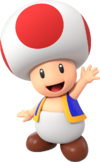 Toad |
A playable character who has the same abilities as Mario and can be used as the second player character in co-op mode. |
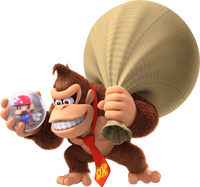 Donkey Kong |
The titular main antagonist of Mario vs. Donkey Kong. After robbing the Mario Toy Company and kidnapping all of the Mini-Mario toys, he faces off against Mario to stop him from retrieving them. |
 Mini-Marios |
Wind-up toys resembling Mario who were kidnapped by Donkey Kong. |
Items and collectibles[edit]
| Item | Description |
|---|---|
 1-Up Mushroom |
Green mushrooms that grant the player(s) an extra life. |
  Flying key |
These keys fly around the level and must be collected to open chests containing extra lives in bonus levels. Unlike the standard keys, they simply follow the player around upon contact. Silver flying keys appear in the main and Mini-Mario levels in multiplayer and are required to open the locked doors or chests in addition to the standard keys. |
 Hammer |
Items that can be grabbed by Mario and used to defeat enemies. |
 Key |
Keys are found in the first half of every regular level of the game. They must be taken to locked doors in order to open the second half. |
Letter Blocks |
Letters that spell out the word "TOY" appearing exclusively in Mini-Mario levels that must be collected to complete the level. They can only be collected by the Mini-Marios. |
   Present |
Wrapped boxes found in red, yellow, and blue varieties. Once all three are collected in a regular or Plus level, the player will earn a Gold Star for that level. |
Enemies and obstacles[edit]
Enemies[edit]
| Enemy | Description |
|---|---|
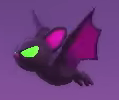 Bats |
Bat enemies that fly horizontally, across the stage, and can cause the player(s) to fall from the rope that they were climbing. |
 Birds |
Avian enemies that fly around and can drop eggs on the player(s), which can be avoided by performing a handstand. |
 Bob-ombs |
Enemies that light their fuses and explode a few seconds after when Mario is near. They can be carried by Mario and used to defeat other enemies. |
 Boos |
Wind-up Boos that chase the player(s) when they are not looking and remain still while they are being watched. |
Brickmen |
A creature hidden in a pile of bricks. They throw three lines of bricks under them, forcing Mario to handstand to avoid being hit. |
 Bucket Men |
Sentient Garbage Can enemies. Mario must be careful when picking up Garbage Cans, as they may really be Bucket Men in disguise. They cannot be picked up, but can be defeated with a hammer. |
 Fire birds |
Flaming avian enemies that fly across the stage and can drop burning eggs on the player(s). |
 Fire Shy Guys |
Snifit-like Shy Guys that attack the player(s) with fire from their mask. |
  Fireballs |
Enemies that move from side to side on a platform. Upon contact, orange ones burn the player and blue ones freeze. |
 Lava Bubbles |
Enemies that are found jumping repeatedly out of lava, and burn the player(s) upon touching them. |
 Monchees |
Mechanical monkeys with long tails that hang below the platforms they are on. Mario can hang from their tails without getting harmed. However, he still loses an extra life if he touches a Monchee's body. |
 Ninjis |
Mechanical enemies wearing black ninja outfits with two red buttons. They jump repeatedly in place, and can be used as platforms to traverse spikes. |
      Polterguys |
Wind-up Shy Guy ghost enemies that transform into blocks when the player(s) press a Color Switch. |
 RamRams |
Purple rhinoceroses resembling Rambi, an animal friend from Donkey Kong Country. They attack by charging at and ramming the player(s). RamRams can be picked up and thrown on to spikes, allowing them to be used as platforms. |
 Robo Kikki |
Robotic enemies with long tails that function identically to Monchee. |
 Shy Guys |
Wind-up Shy Guys that walk throughout the levels, and can be jumped on. |
 Sir Shovalots |
Knight-like enemies that push the player(s) using their shield. |
 Snapjaws |
Crocodile-like enemies that climb ropes. They can only be defeated by falling fruit. |
 Spear Guys |
Enemies that are first found sleeping. Once Mario gets near them, they wake up and start running after him. They go back to sleep if they touch a platform's edge. |
 Tane Pakkun |
Mechanical Piranha Plants that spit fireballs, which damages the player(s) upon contact. |
 Thwimps |
Enemies that attempt to crush the player(s) when they get close. |
 Thwomps |
Enemies that fall down when the player(s) approach them. Touching one causes an extra life to be lost. |
 Wrench Shy Guys |
Black Shy Guys that throw spanners which fly in a straight line towards the player. |
Obstacles[edit]
| Obstacle | Description |
|---|---|
 Bird Nest |
Objects that birds can spawn from. |
 Candle |
Obstacles that moves up and down and burn the player(s) on contact. They can be defeated with a Hammer. |
 Cannon |
Obstacles that tilt up and down, firing cannonballs. |
 Cannonball |
Obstacles that are fired from cannons. |
 Falling spike |
Spikes that fall from ceilings as Mario gets near them. Falling spikes that get stuck on the ground act as temporary platforms for the player. |
      Flower Fan |
Floating, fan-like flowers that produce a continuous gust, which can carry Mario and various objects in one direction. Flower Fans of a specific color are activated simultaneously by pressing a corresponding Color Switch. |
 Icicle |
Icy stalactites that function identically to falling spikes. |
 Lava Geyser |
Spouts of lava that rise and cause Lifts to float on top of them, allowing the player(s) to reach higher ground. |
 Oil |
Obstacles that move up and down and burn the player(s) on contact. They can be defeated with a Hammer. |
Spike |
Harmful traps that cause the player(s) to lose a life if touched. |
 Spiked Barrel[14] |
Barrels with spiked rims that are thrown as projectiles by Donkey Kong in certain boss battles. |
 Thwomp Platform |
Grey and yellow stone blocks that rise when the player(s) stand on them. |
 Wire Trap |
Indestructible balls of electricity that travel along wires and electrocute Mario upon contact. |
Objects[edit]
Blocks[edit]
| Block | Description |
|---|---|
 Bob-omb Block |
Blocks that can only be destroyed by Bob-ombs. |
  Color Block |
Blocks that become solid once a Color Switch of the same color is activated by the player(s), however any blocks that are of the inactive color will become inactive and intangible. |
 Donut Block |
Orange blocks that fall if the player stands on them for too long. |
 Help Block |
Gray and black variants of ? Blocks that give the player(s) hints and information about the game when hit. |
 Ice Block |
Light blue frozen blocks that come in solid and semisolid variants, and often connect to form icy terrain with slippery traction affecting thrown objects and the player(s). |
 Sand block |
Blocks that crumble into dust when stood on. |
 Warp Box |
Clear boxes that teleport the player to another box with the corresponding color and are activated by Color Switches. |
Platforms[edit]
| Platform | Description |
|---|---|
Lift |
Platforms that are found traveling along tracks, or being lifted by Lava Geysers. |
Semisolid Platform |
Platforms of varying styles that have solid surfaces, but can be jumped through from below. |
Other[edit]
| Object | Description |
|---|---|
 Barrel |
Can be carried and thrown by the player(s). They can be used to defeat certain enemies, or as auxiliary platforms to reach other platforms or to pass wide gaps with spikes. |
  Checkpoint Flag |
A flag with Mario's insignia on it that acts as a checkpoint for players in the Casual Style. Inactive Checkpoint Flags can be unfurled by coming into contact with one, which will become a new checkpoint that the player will return to upon getting bubbled. |
Color Switch |
Switches that are found in three versions: red, yellow, and blue. As the main effect, the switch that is active makes platforms, blocks, and ladders of the same color available to use. |
 Direction Switch |
A switch that reverses the current direction of moving platforms and conveyor belts. |
 Garbage Can |
Can be carried and thrown by the player(s). They can be used to defeat certain enemies, or as auxiliary platforms to reach other platforms or to pass wide gaps with spikes. |
   Ladder |
Climbable objects of various lengths and visual styles. Some can be toggled by Color Switches, with inactive ones appearing as dotted-lines and cannot be climbed. |
Rope |
Climbable objects that hang from trees or metal rings. The player can climb on them in a similar fashion to the vines from Donkey Kong Jr.. Snapjaws can be found moving along some vertical ropes. |
 Spring |
Can be jumped off of to reach high platforms. |
 Toy box |
Objects that serve as the goal in Mini-Mario levels and can be opened by collecting all three Letter Blocks in the level. |
Track |
Objects that constantly move platforms along a set path. |
 Trampoline |
Functions the same as springs but can also be picked up and thrown. |
Wire |
Horizontal cables that the player can hang on to and move across. The player can also perform a Wire Spin on them to launch themselves to higher places. In worlds like Donkey Kong Jungle, wires take the appearance of horizontal ropes. |
Demo[edit]
A demo for the game was released on January 31, 2024 via the game's Nintendo eShop page, featuring a limited version of the game's first world, Mario Toy Company. The following differences are present in the demo version of the game:
- The intro cutscene does not play upon first starting up the game, instead it immediately boots to the title screen.
- The title screen features only two options: "Play Demo" and "Nintendo eShop". Selecting the latter option will allow the player to check out the game's relevant eShop page. As such, the file select menu and Gallery are absent, and accessing Guides and Controller options can only be done from the pause menu.
- Multiplayer is still available, as with the option to choose between the Casual or Classic play styles.
- The only playable levels are Level 1-1, Level 1-3, Level 1-5, and Level 1-mm. The player can gain a total of four gold stars from them.
- Additionally, the name of the world ("Mario Toy Company") is not displayed, instead showing the Mario vs. Donkey Kong logo. The world name can still be seen in the pause menu and in the level results screen.
- Completion of Level 1-mm does not lead to Level 1-DK, rather it leads to the demo video, which is a trailer that showcases various features and levels from the full version of the game.
- The demo video is treated like a cutscene, which can also be skipped by holding
. Once the video finishes playing, the player is asked if they want to check out the eShop page for the game.
- The demo video is treated like a cutscene, which can also be skipped by holding
- A new menu appears after beating the game - the Product Info page, which can be viewed either by selecting No after watching the demo video for the first time, or by pressing
while on the level select screen. (see below section for more details)
- Some oddities are present in the demo:
- An audiovisual bug is present in which Mario's burn animation is slightly incomplete - it lacks a burning sound and a smoke effect, while Mario's animations are still functional. This can be seen if Mario is defeated by touching Oil.
- When viewing Mario's moves via the Guides menu (accessed via the pause screen), there are still references to moves related to climbing ropes - these only appear in Donkey Kong Jungle onward, which cannot be played in the demo.
Product info[edit]
The Product Info page is displayed with the following text: "THANK YOU FOR PLAYING! - You can check out the full version to see the rest!". A link to the Nintendo eShop page for the game as well as the demo video and six preview screenshots are present in the page. The player can view the screenshots in full by selecting them with . The player is taken to the title screen after exiting the page if seen after beating Level 1-mm.
The following table lists the contents of the Product Info page for the demo version:
| Product Info page (Mario vs. Donkey Kong Demo) | ||
|---|---|---|
| Image | Caption | Notes |
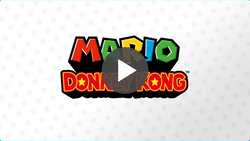
|
Demo Video | The demo video that is initially displayed upon completion of the demo. It is treated like a cutscene, which means the player can also completely skip it. |
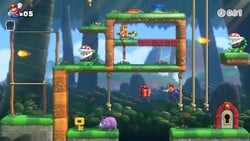
|
Puzzle and platform through over 130 levels! | The level shown is Level 2-6. |
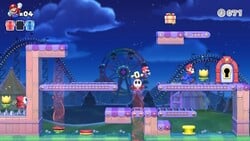
|
New ways to play through multiple modes! | The level shown is Level 4-2+. |
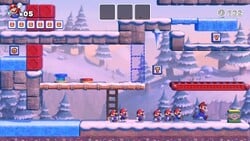
|
Rescue all the Mini-Marios! | The level shown is Level 6-mm. |

|
Play with a friend in local co-op! | The level shown is Level 3-4. |
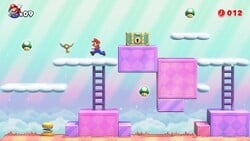
|
Discover numerous bonus levels! | The level shown is the bonus level for Mario Toy Company. |
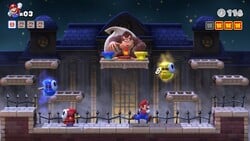
|
Face Donkey Kong in exciting boss fights! | The level shown is Level 5-DK. |
Reception[edit]
| Reviews | |||
|---|---|---|---|
| Release | Reviewer, Publication | Score | Comment |
| Nintendo Switch | Charles Harte, GameInformer | 8/10 | "Mario vs. Donkey Kong is a simple game, but as is the case with Mario's best titles, there's an elegance to that simplicity. Nintendo has done a stellar job adding features to make it more palatable to a modern audience, but it only comes together because of how well the classic levels hold up. Mario and Donkey Kong have been rivals for over 40 years, and this game admirably carries that legacy forward." |
| Nintendo Switch | Steve Watts, GameSpot | 7/10 | "Mario vs. Donkey Kong feels very retro in certain respects. It's designed to be played in short bursts, which can feel anachronistic on a modern handheld hybrid that's perfectly suited for long play sessions. But it's also a throwback in the best ways, recapturing the clever aha moments of puzzle-platforming that made its predecessors so memorable, all while packing distinct visual improvements and quality-of-life tweaks that bring out its charm like never before." |
| Nintendo Switch | Eric Van Allen, Destructoid | 7.5/10 | "I could see myself blasting through levels of Mario vs. Donkey Kong while waiting for a flight at the airport, or on the train to work, and that’s the best-case scenario for this package, brimming with bite-sized platforming challenges. It may not contain all the spectacle of others, but there’s enough precise jumping and quick calculations here to satisfy the more hardcore, goal-oriented, score-chasing Mario players around." |
| Aggregators | |||
| Compiler | Platform / Score | ||
| Metacritic | 77 | ||
Sales[edit]
As of March 31, 2024, the game had sold 1.12 million units worldwide.[15]
Promotion[edit]
- By pre-ordering the game through Otakara, customers received a tin badge depicting Donkey Kong.[16]
- A bundle containing the game, a 40-piece puzzle, and a set of three stickers is sold on the European My Nintendo Store.[17]
Media[edit]
| File info 0:30 |
References to other media[edit]
- Dance Dance Revolution: Mario Mix: Mario's official artwork uses the same pose as this game, albeit updated.
- Mario Kart Wii: At least one of Mario's voice clips is reused from this game, as are some of Donkey Kong's voice clips.
- Mario vs. Donkey Kong: Mini-Land Mayhem!: The background of Merry Mini-Land is seemingly based on Coaster Hills, an attraction from this game.
- Super Mario 3D Land: Mario's humming in one of the cutscenes is reused from this game.
- Super Mario 3D World: Some of Mario's voice clips are reused from this game. The heads-up display is also somewhat adapted from this game including its font, although the character portraits are rendered 3D models instead of 2D artwork.
- Mario Kart 8: Some of Donkey Kong's voice clips are reused from this game.
- Super Mario Maker: Builder Toads can be seen working in the Mario Toy Company building's factory.
- Mario Party: Star Rush: Mario's render for this game is reused for his life icon while Toad's life icon is a recolored variant of other colored Toads' renders.
- Mario Party Superstars: Toad's artwork from this game is repurposed.
Staff[edit]
- Main article: List of Mario vs. Donkey Kong (Nintendo Switch) staff
Mario vs. Donkey Kong was developed by the Nintendo Software Technology Corporation, who developed every previous game in the series including the original game. Vivek Melwani, who was previously involved with Super Mario 3D World + Bowser's Fury, took on director duties for the remake. Lawrence Schwedler, after leaving NST to work at the DigiPen Institute of Technology around 2012, returns as the music director for the remake, along with bringing DigiPen's music department to help compose the music.
Gallery[edit]
- For this subject's image gallery, see Gallery:Mario vs. Donkey Kong (Nintendo Switch).
Mario inside a bubble
Mario using a Hammer
A Mini-Mario inside an orb
Mario holding a Key
Names in other languages[edit]
| Language | Name | Meaning | Notes |
|---|---|---|---|
| Japanese | マリオ Mario buiesu Donkī Kongu |
Mario vs. Donkey Kong | |
| Chinese (simplified) | 马力欧vs.咚奇刚[?] Mǎlì'ōu vs. Dōngqí Gāng |
Mario vs. Donkey Kong | |
| Chinese (traditional) | 瑪利歐vs.咚奇剛[?] Mǎlì'ōu vs. Dōngqí Gāng |
Mario vs. Donkey Kong | |
| Korean | 마리오 vs. 동키콩[?] Mario vs. Dongki Kong |
Mario vs. Donkey Kong |
References[edit]
- ^ Initial post about the Instagram story from an NST contractor Instagram story itself
- ^ Nintendo (January 12, 2024). Mario vs. Donkey Kong | Nintendo Switch | Nintendo.
- ^ a b Nintendo of America (September 14, 2023). Nintendo Direct 9.14.2023 - Nintendo Switch. YouTube. Retrieved September 14, 2023.
- ^ Latin American website. Nintendo.com (in Spanish).
- ^ Brazilian website. Nintendo.com (in Portuguese).
- ^ @NintendoEurope (September 14, 2023). "The toys are back in town! Recover the stolen Mini-Marios in this Game Boy Advance classic updated for #NintendoSwitch. Mario vs. Donkey Kong launches 16/02/2024! #NintendoDirect". Twitter. Retrieved September 14, 2023.
- ^ NintendoAU (September 14, 2023). Mario vs. Donkey Kong marches onto Nintendo Switch February 16th, 2024. YouTube. Retrieved September 14, 2023.
- ^ (September 14, 2023). 『프린세스 피치 Showtime!』, 『페이퍼 마리오 1000년의 문』, 『루이지 맨션 2 HD』, 『마리오 vs. 동키콩』 등, Nintendo Switch로 발매되는 타이틀의 최신 정보를 전달! Nintendo Korea. Retrieved September 14, 2023.
- ^ (September 14, 2023). 《瑪利歐vs.咚奇剛》的最新資訊公開!本作預定於2024年2月16日(五)發售。 Nintendo HK. Retrieved September 14, 2023.
- ^ (February 16, 2024). Nintendo Switch《瑪利歐vs.咚奇剛》本日發售。現正公開迷你瑪利歐的定格影片。 Nintendo TW. Retrieved February 21, 2024.
- ^ https://twitter.com/NintendoAmerica/status/1752859619943194810
- ^ https://nintendosoup.com/all-first-party-nintendo-physical-games-in-southeast-asia-will-not-have-a-rating-on-the-cover-starting-from-another-code/
- ^ "Casual Style: For a more relaxed experience, this style of play removes the timer, adds checkpoints, and boosts the number of times Mario can get hit." -Mario vs. Donkey Kong™ for Nintendo Switch - Nintendo Official Site. (n.d.). Retrieved June 24, 2024, from https://www.nintendo.com/us/store/products/mario-vs-donkey-kong-switch/
- ^ Mario vs. Donkey Kong (Nintendo Switch) internal filename (Model/BarrelSpiked.bfres.zs)
- ^ Nintendo (May 7, 2024) [1]. Financial Results Explanatory Material, Nintendo Co., Ltd. Retrieved May 8, 2024.
- ^ 【オリジナル特典】マリオvs.ドンキーコング 予約受付中 Otakarasoko.
- ^ Mario vs. Donkey Kong + Puzzle + Set of 3 Stickers. store.nintendo.co.uk. Retrieved January 14, 2024. (Archived January 14, 2024, 22:30:06 UTC via archive.today.)
External links[edit]
- Official North American game page
- Official Canadian (French) game page
- Official Latin American game page
- Official Brazilian game page
- Official Japanese game page
- Official Japanese My Nintendo Store page
- Official United Kingdom game page
- Official Belgium (Dutch) game page
- Official Belgium (French) game page
- Official German game page
- Official España game page
- Official French game page
- Official Italian game page
- Official Dutch game page
- Official Austrian game page
- Official Portuguese game page
- Official Swiss (German) game page
- Official Swiss (French) game page
- Official Swiss (Italian) game page
- Official South African game page
- Official Australian game page



